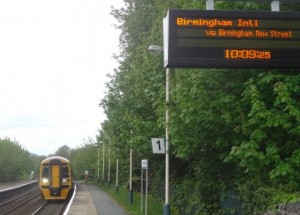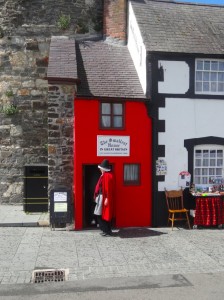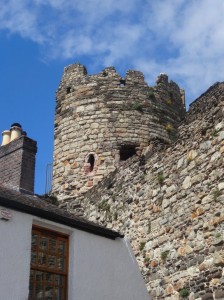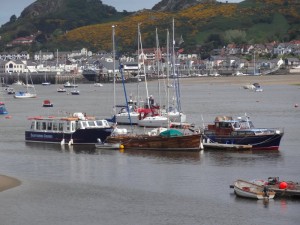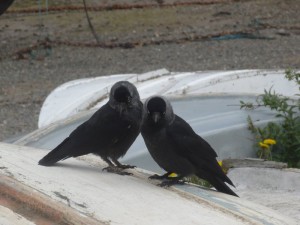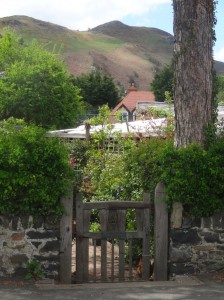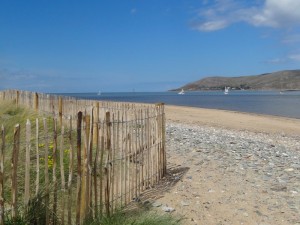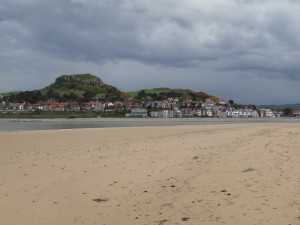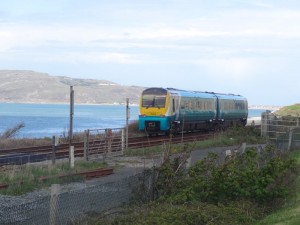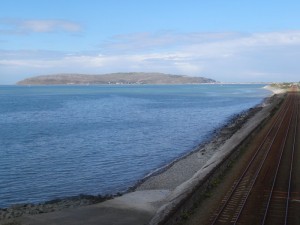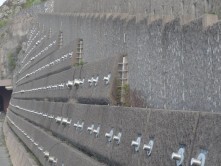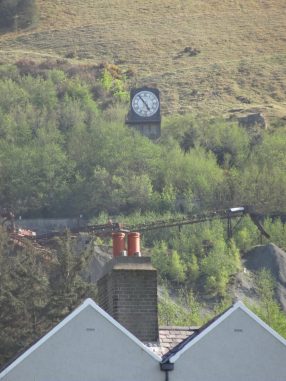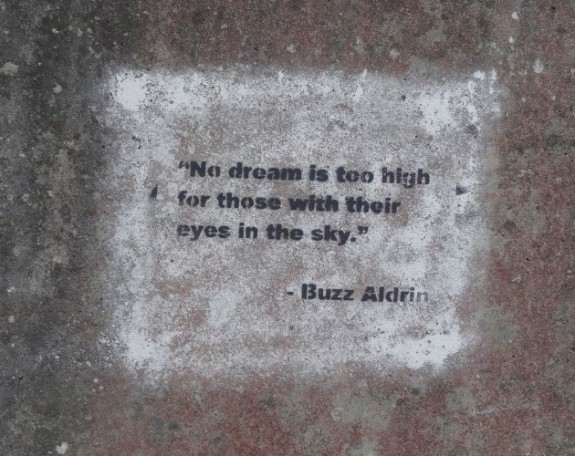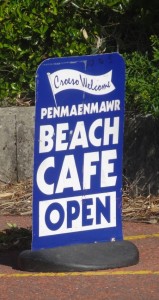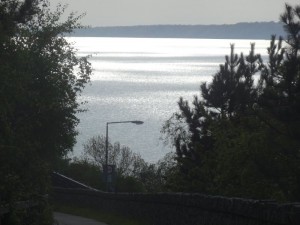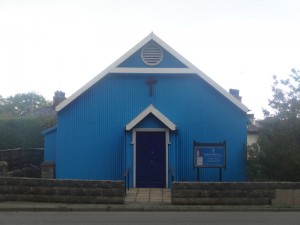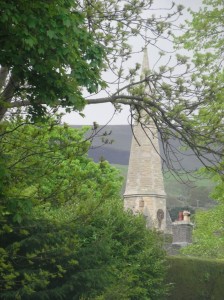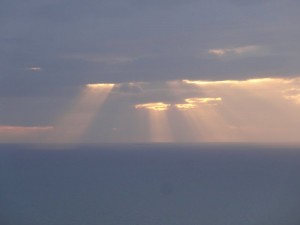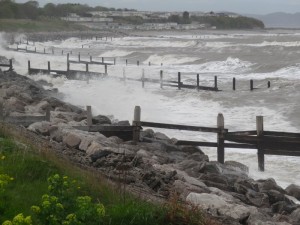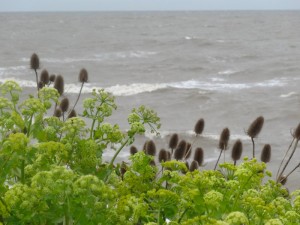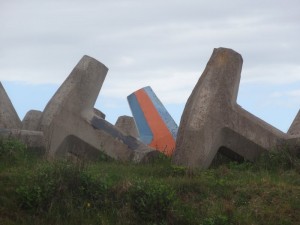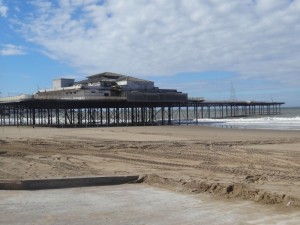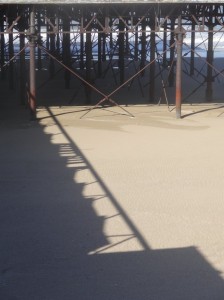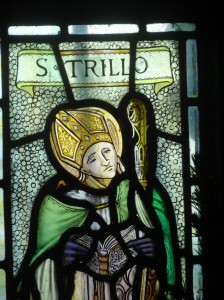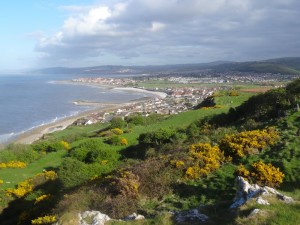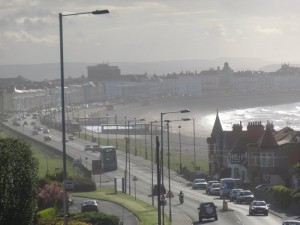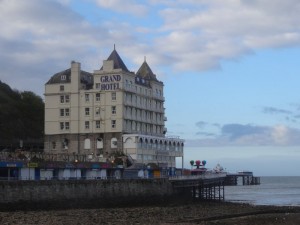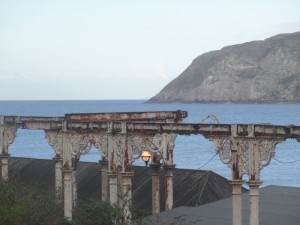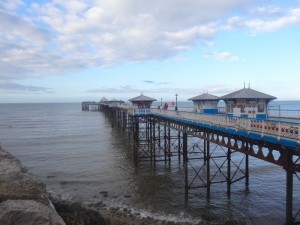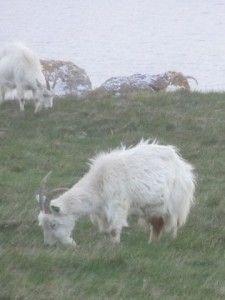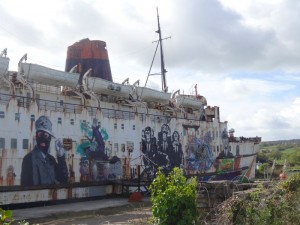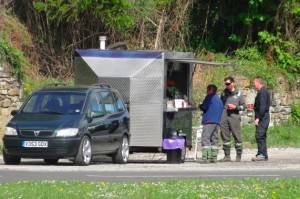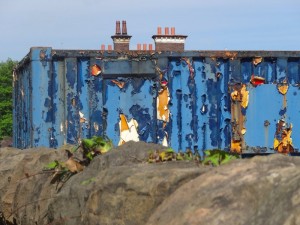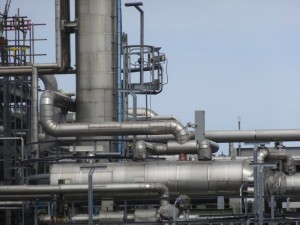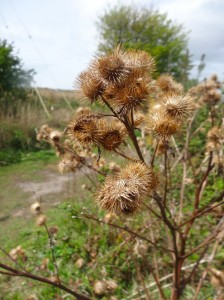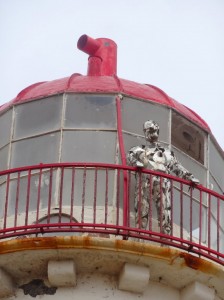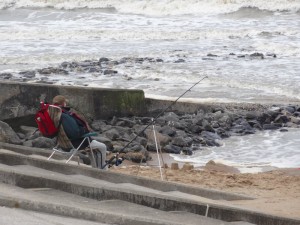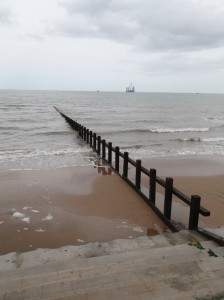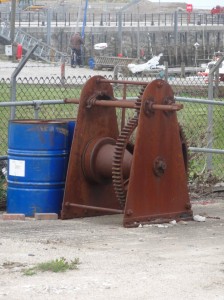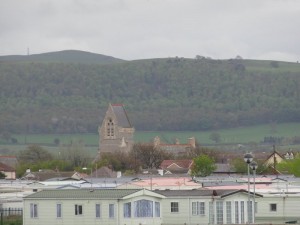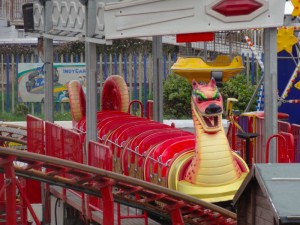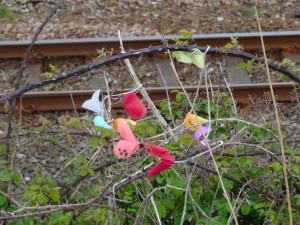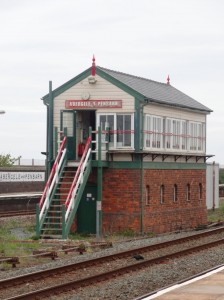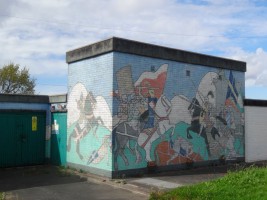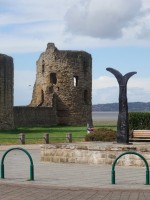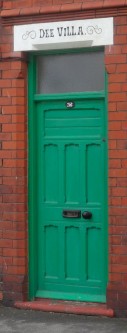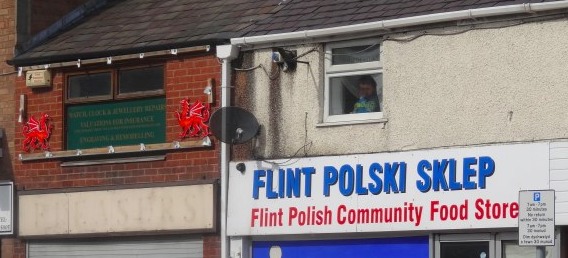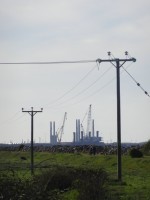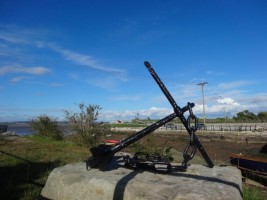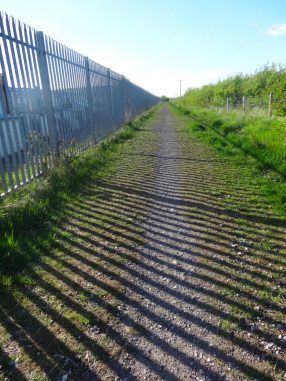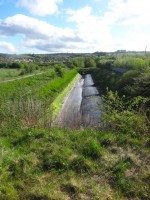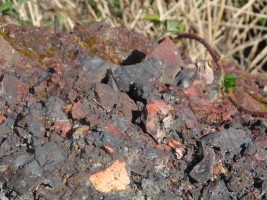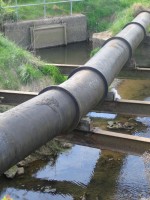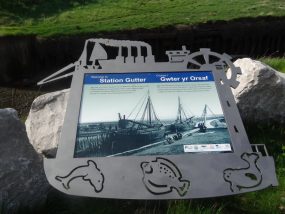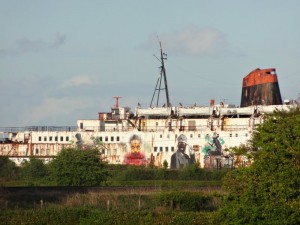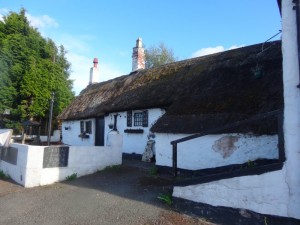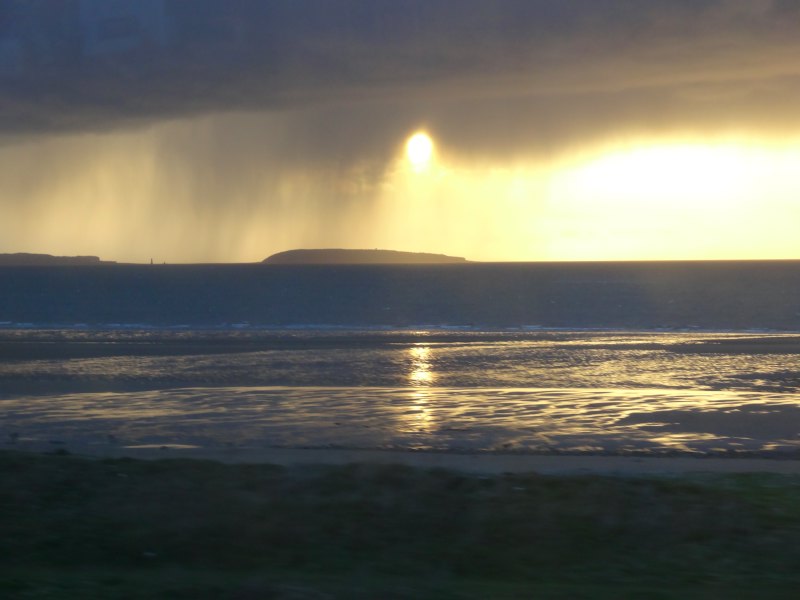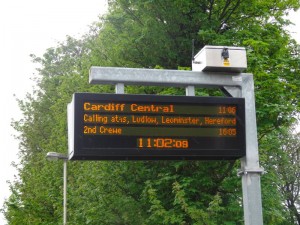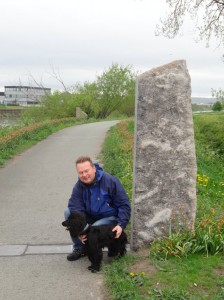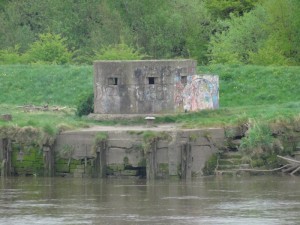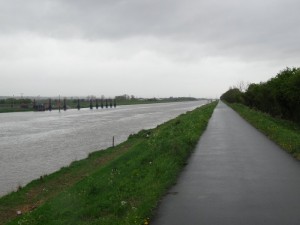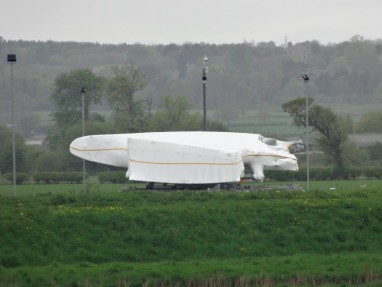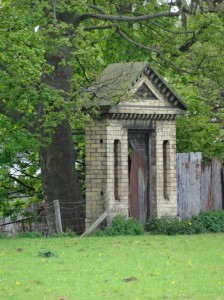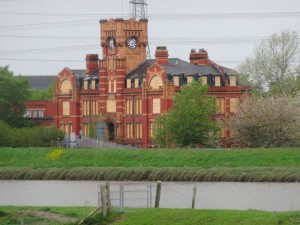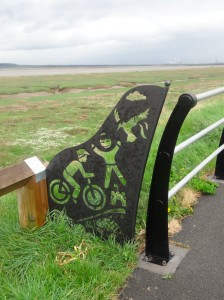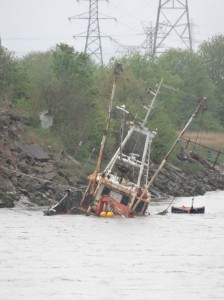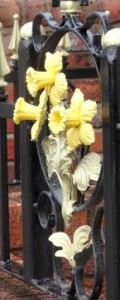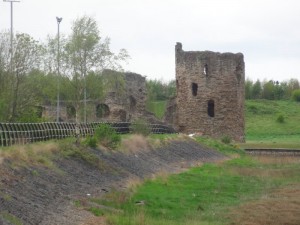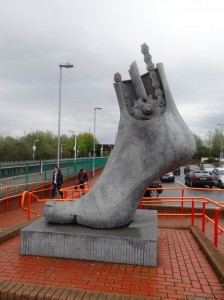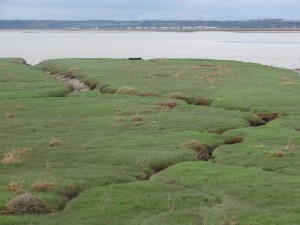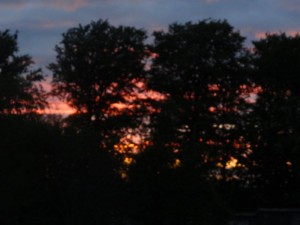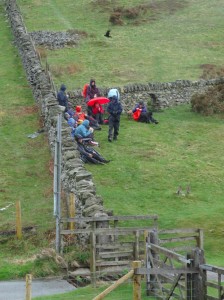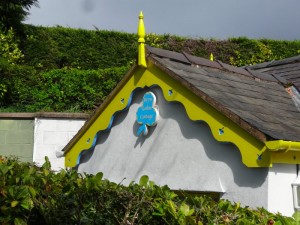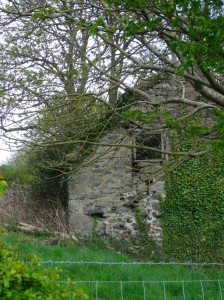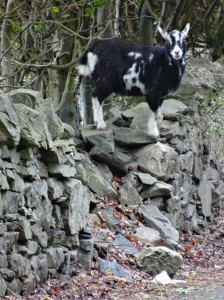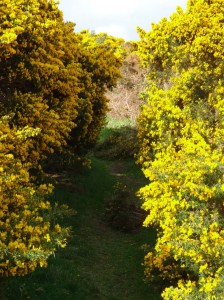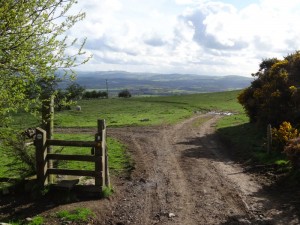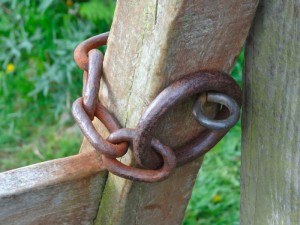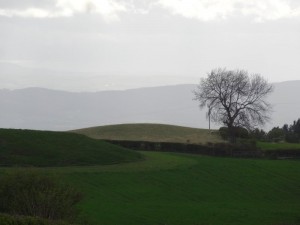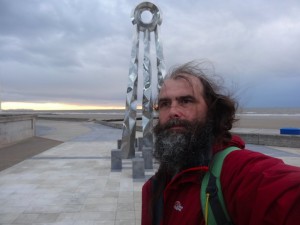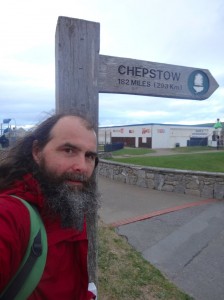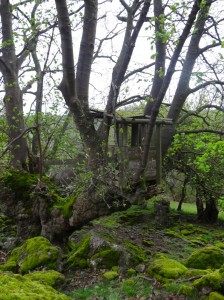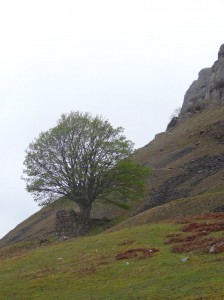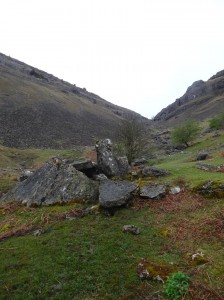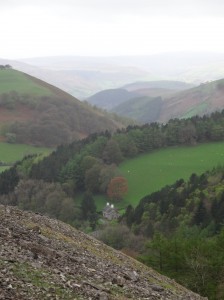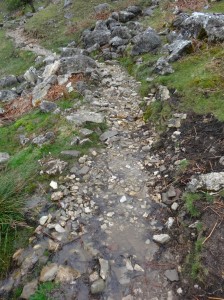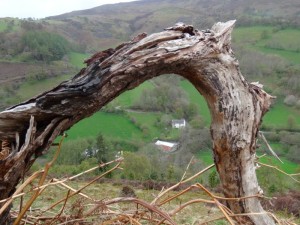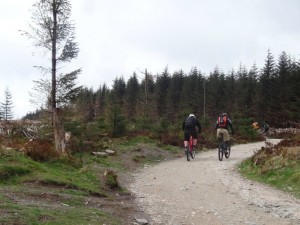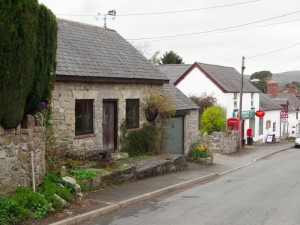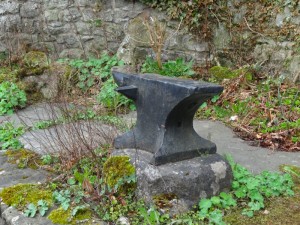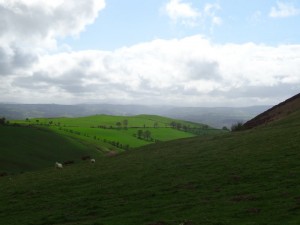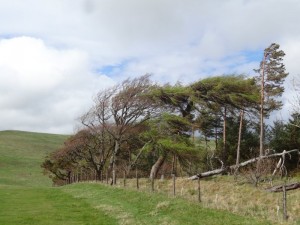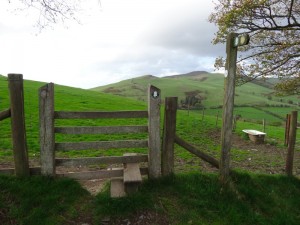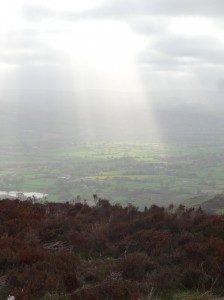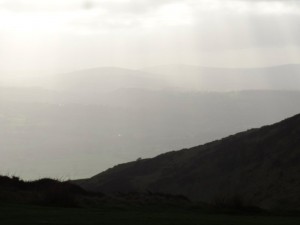The day starts at the crossroads in the centre of Llanfairfechan, following the main street down towards the sea. But take a moment to look back as several streets join at acute angles leaving strangely thin-ended shop ends at their cusp. They remind me of the Point Hotel in Edinburgh, only on a smaller scale.
The seaside area is quiet, but neat, with a large pond and grassy park. The Llanfairfechan information board says, ‘Welcome to the Quarry Villages’, and like Penmaenmawr yesterday, I wonder at what makes one post-industrial community thrive and others fail. The environment must help, estuary mud vs. open seas, and the fact that quarrying or coal mining, while dangerous, are less noxious to the community as a whole than the chemical industry of Flint. However, when I think of the coal tips of the South Wales valleys and the Aberfan disaster, that is not a compelling argument. Part of me wonders, although it may be a poetic rather than practical explanation, whether the act of digging rock from the ground, like that of farming, forges a connection between a people and their land that fosters a sense of belonging to the shared earth and each other.
Stretched out between Llanfairfechan and Bangor are a series of nature reserves making up the Traeth Lavan reserve. The tidal mudflats stretch nearly across to Anglesey, and indeed there are local stories of when there was solid ground all the way across to Anglesey, a lost kingdom drowned in a catastrophic inundation. Certainly the remains of drowned forests are visible here at low tides, just as they are in Cardigan Bay. Today it is the sea birds and waders who pick shellfish and worms where the legendary palaces stood.
The Coast Path largely skirts the nature reserves, presumably to avoid damage, although with the volume of walkers I have met, this seems over cautious. Because of this at one stage I took a path along a dyke, slightly closer to the sea than the official route, and there, seen only by passing dog walkers and grazing sheep, is a maze. Not a deep hedged puzzle maze like Hampton Court, but laid out in stones on the ground. It is a traditional unicursal maze, or labyrinth, that is a single path, no choices or branches, but the path folded back and forth on itself, like a twisted swiss-roll. The aim is not to ‘solve’ it, but simply to follow it, sometimes getting closer to our goal, sometimes further away, like navigating a one-way system.
I follow it all the way to the centre, where votive offerings of seashells and sheep dung show that nature has its own ways of marking, and then back along the same path out again.
The unicursal maze seems, to a modern eye, senseless, no challenge, leading nowhere but back to where you started; you could even step over the stones and ignore the path … but you don’t. Just like my walk, starting and ending at the same point, occasionally the line of the path means that path distance and world distance are at odds, such as at Milford Haven where less than 2 miles across the bay is more like 20 miles walking inland to a crossing point.
However, the point of the traditional maze is not the getting to the place where it ends, but the act of following it, and in doing so both we and the place are changed.
We shall not cease from exploration
And the end of all our exploring
Will be to arrive where we started
And know the place for the first time.
T. S. Eliot, Four Quartets
During the 10 miles from Llanfairfechan to Bangor the environment changes. The lushness that was already apparent in the semi-Mediterranean plants the previous day intensifies as the land passes into the protection of Anglesey, all the warmth of the Gulf Stream, but without the full intensity of sea winds. And passing a small woodland, I catch a smell familiar and yet half-forgotten; it is wild garlic, the first since the southern part of Offa’s Dyke.
The quarries of the hinterland also shift from limestone to slate, and while the quarries themselves are well inland, the field boundaries are marked not by hedgerow or stone wall, but slate fences, thin upright slabs, like planks, about one inch thick and eight inches wide, their feet buried in the ground and tops bound together with wire. I have seen slate fencing in the Lake District, but there larger slabs are used, simply buried in the ground, their edges lapping, like close fitting megaliths. This finer, picket-fence-like North West Wales design depends crucially on metal wire, which, I believe, was only made in quantity in the late 19th century, so did this kind of fencing evolve since then, or maybe it is older, but relying on burying more of the slate.
Penrhyn Castle is the focus for much of the journey, gradually appearing and getting closer. The path does not run past the castle itself as it is set on an island amid the estuary of the River Ogwen, reached by a meandering causeway. While Harlech Castle is defended by being set on a high cliff, Penrhyn Castle is defended by mud.
At one point the path appears to disappear completely, the sea-edge lane stopping abruptly. Clambering down the hazardous loose rocks to the clinging high-tide mud I thought I must have made a mistake, until, little more than a hundred yards later, the path re-appears along a grassy dyke. Later, however, I really did go wrong: instead of following the scenic route into Bangor, I found myself in the middle of an industrial estate. But maybe there are no wrong turns, merely wrong ways of seeing the opportunities of the unexpected; in the industrial estate was a sausage and burger van :-).
I have arranged to meet Eban at the Clock Tower. The Coast Path leads round the north-west side of the city, so I have to cut over and down the hill that rises in the centre of Bangor, the old University building at its top. The sign entering Bangor says ‘City of Learning’, and even the football club is sponsored by ‘Studentopia‘ and has a ‘BookPeople‘ stadium.
The way to the Clock Tower passes the tiny cathedral. I poke my head through the doors to take a quick peek, but am captivated, a scene of activity and colour. I have been on the road for many weeks now and had lost track of the time, it is Pentecost, Whitsun, and the pillars are being hung with banners of flame remembering the wind that shook the building and fire that hung over the heads of the disciples as the Holy Spirit, like a defibrillator in hospital, shocks life into the nascent Jerusalem church.
I am pleased also to see large posters about food distribution at the cathedral, so important now that many are dependent on food banks to survive. I recall with tenderness and admiration St Augustine’s church in Halifax, who 30 years ago decided that they could do without their building and instead focused on building their support for the community around. It is a tiny congregation and yet has an impact so far beyond its size, one of the more recent projects being food distribution bringing together churches across Halifax, which includes some of the most deprived areas of the UK.
Slightly late due to the unplanned ecclesiastical excursion, I meet Eban, a lecturer in film, digital media and communications at Bangor University, and have a wonderful conversation in the Blue Sky Café, which I had previously visited for a lovely breakfast with Thora (also at Bangor University), back in January.
Although Thora and Eban both worked at Bangor, they were in different departments and so did not know they had overlapping interests. It was great to be able to introduce them, especially as I had only come into contact with them both through introductions from others as I planned the walk. Rebecca Solnit talks about the way walking, almost like a sewing thread, binds together, and so there is something symbolic about the way connections are made even by the planning of walking.
In his youth Eban walked the Appalachian trail, four months, 2000 miles, and issues of space and folklore are a significant part of his research as well as the nature and future of bookshops; well, you can’t get better than that! We talked about community, the memories of community, and the dying of village shops as well as about feet, backpacks and hydration.
To end the day I walked the final few miles from Bangor across the Menai Suspension Bridge and onto Anglesey – the next stage. It was interesting to note that the longstanding need for a safer and faster route across the Menai Straits was kicked into action by the 1801 ‘Act of Union‘ (bringing Ireland into the UK). Was this purely about increased trade, or also to be able to move troops out there more quickly should the need arise?

